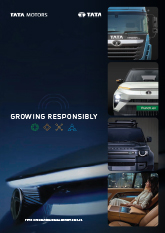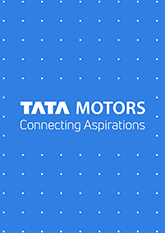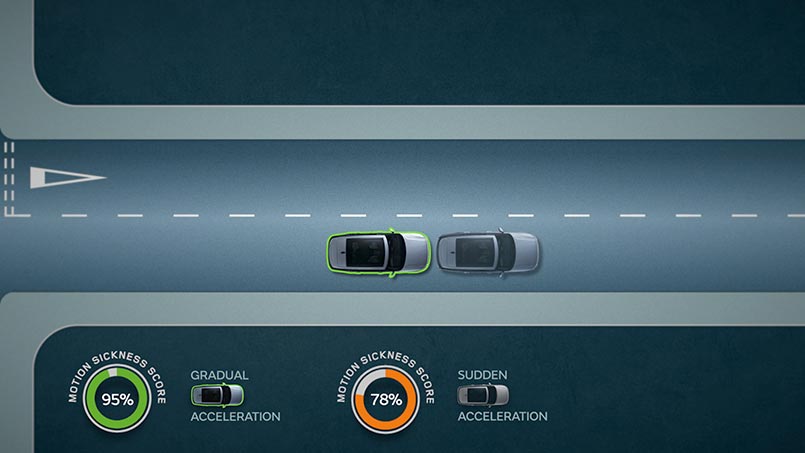JLR Press Archive -
August 05, 2020
Jaguar Land Rover teaches driverless cars how to reduce motion sickness
- Pioneering research into autonomous vehicles is part of Jaguar Land Rover’s journey to zero accidents and zero congestion
- Autonomous vehicles will be programmed to drive in a way that reduces the impact of motion sickness
- Intelligent software adjusts acceleration, braking and lane positioning to avoid inducing nausea
- Motion sickness affects more than 70% of people* around the world
 Jaguar Land Rover is pioneering software that will reduce motion sickness by adapting the driving style of future autonomous vehicles, to continue to provide our customers with the most refined and comfortable ride possible.
Jaguar Land Rover is pioneering software that will reduce motion sickness by adapting the driving style of future autonomous vehicles, to continue to provide our customers with the most refined and comfortable ride possible.
During the first phase of the project, a personalised ‘wellness score’ was developed which could reduce the impact of motion sickness by up to 60%. Experts at Jaguar Land Rover’s specialist software engineering facility in Shannon have now implemented that score into self-driving software.
The intelligent software combines 20,000 real-world and virtually-simulated test miles to calculate a set of parameters for driving dynamics to be rated against. Advanced machine learning then ensures the car can optimise its driving style based on data gathered from every mile driven by the autonomous fleet.
This technology can then be used to teach each Jaguar and Land Rover vehicle how to drive autonomously, while maintaining the individual characteristics of each model, whether that’s the thoroughbred performance of a Jaguar or the legendary capability of a Land Rover. All helping Jaguar Land Rover’s continued development of the ultimate cabin experience in an autonomous, electric and connected future.
Motion sickness, which affects more than 70 per cent of people*, is often caused when the eyes observe information different from that sensed by the inner ear, skin or body – commonly when reading on long journeys in a vehicle. Using the new system, acceleration, braking and lane positioning – all contributory factors to motion sickness – can be optimised to avoid inducing nausea in passengers.
As a result of the project, engineers are now able to develop more refined advanced driver-assistance systems (ADAS) features on future Jaguar and Land Rover models, such as adaptive cruise control and lane monitoring systems. The in-depth knowledge is helping Jaguar Land Rover design and manufacture capable and advanced vehicles, both now and in the future.
Dr Steve Iley, Jaguar Land Rover Chief Medical Officer, said: “Mobility is rapidly changing, and we will need to harness the power of self-driving vehicles to achieve our goal of zero accidents and zero congestion. Solving the problem of motion sickness in driverless cars is the key to unlocking the huge potential of this technology for passengers, who will be able to use the travelling time for reading, working or relaxing.”
This is another step for Jaguar Land Rover on its journey to Destination Zero: an ambition to make our societies safer and healthier and our environments cleaner through relentless innovation. With the mission of raising the quality of future urban living, Jaguar Land Rover has also revealed Project Vector, an advanced autonomy-ready concept for future mobility.
In a post COVID-19 world, where a ‘new normal’ is emerging, customer expectations of private transport are changing, and the focus will be on safe, clean mobility where personal space and hygiene will carry a premium. New technologies and materials are being developed to meet these expectations at Jaguar Land Rover with today’s vehicles designed to help improve passenger wellbeing, including a Driver Condition Monitor and antimicrobial wireless device charging. In addition, features such as cooling seats, ambient lighting and multiple seat configurations are proven to significantly reduce the likelihood of motion sickness.
Jaguar and Land Rover models offer adaptive dynamics across its range of vehicles which help to remove low frequency motion from the road, which can lead to nausea. By altering the ride settings every 10 milliseconds, this ensures passengers always experience high levels of comfort, while also maintaining the dynamic performance DNA of every Jaguar and Land Rover model.
Editor’s notes:
* Reason, J.T. and Brand, J.J. (1975) Motion Sickness. Oxford, England: Academic Press
For more information about Destination Zero please visit: https://www.jaguarlandrover.com/2019/destination-zero
About Jaguar Land Rover
Jaguar Land Rover is the UK’s largest automotive manufacturer, built around two iconic British car brands. Land Rover is the world’s leading manufacturer of premium all-wheel-drive vehicles. Jaguar is one of the world’s premier luxury marques, as well as being the first ever brand to offer a premium all-electric performance SUV, the Jaguar I-PACE.
At Jaguar Land Rover we are driven by a desire to deliver class-leading vehicles, providing experiences people love, for life. Our products are in demand around the globe and in 2019 we sold 557,706 vehicles in 127 countries.
At heart we are a British company, with two major design and engineering sites, three vehicle manufacturing facilities, an Engine Manufacturing Centre and soon to be opened Battery Assembly Centre. We also have vehicle plants in China, Brazil, India, Austria and Slovakia. Three of our seven technology hubs are in the UK – Manchester, Warwick (NAIC) and London – with additional sites in Shannon, Ireland, Portland, USA, Budapest, Hungary and Changshu, China.
We have a growing portfolio of electrified products across our model range, embracing fully electric, plug-in hybrid and mild-hybrid vehicles, as well as continuing to offer the latest diesel and petrol engines, giving our customers even more choice.
We are confident that our comprehensive strategy, exciting pipeline of market-leading vehicles and innovative approach to technology and mobility will see us continue to progress towards Destination Zero, our mission to shape future mobility with zero emissions, zero accidents and zero congestion.







 Jaguar Land Rover is pioneering software that will reduce motion sickness by adapting the driving style of future autonomous vehicles, to continue to provide our customers with the most refined and comfortable ride possible.
Jaguar Land Rover is pioneering software that will reduce motion sickness by adapting the driving style of future autonomous vehicles, to continue to provide our customers with the most refined and comfortable ride possible.